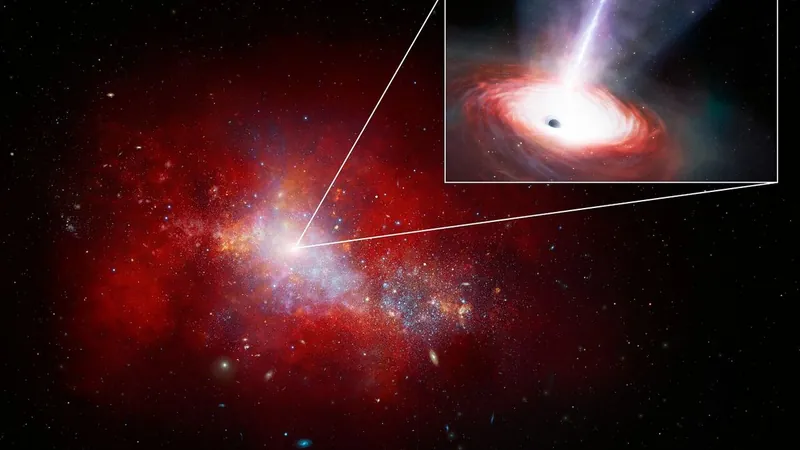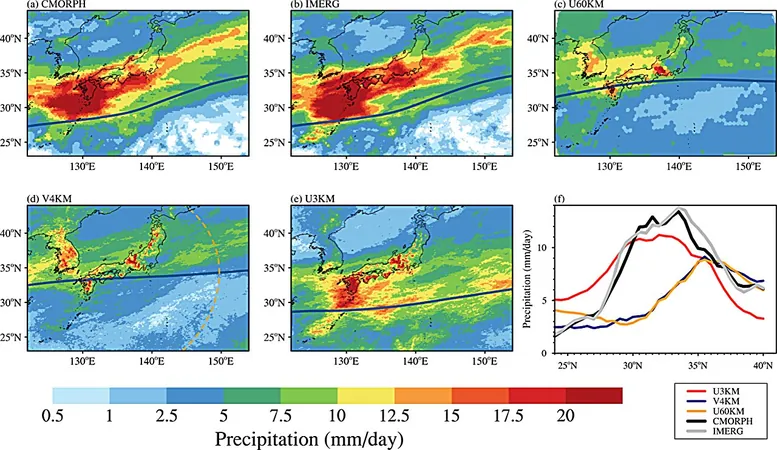
Unraveling the Mystery: The Fastest-Feeding Black Hole Found in the Early Universe – Are Physics Laws at Stake?
2024-11-06
Author: Amelia
The Discovery of LID-568
Astronomers have made an astonishing discovery in the depths of the cosmos: the earliest known black hole displaying the fastest rate of growth is now cataloged as LID-568. This remarkable find, a product of collaboration between NASA's James Webb Space Telescope (JWST) and the Chandra X-ray Observatory, has left scientists both thrilled and puzzled.
Unprecedented Growth Rates
LID-568 has been observed feasting on matter at a jaw-dropping pace, amassing over seven million times the mass of our Sun in merely 12 million years. This rapid accretion challenges existing theories about how black holes could develop such immense masses in the juvenile universe, sparking debates about the fundamental principles of astrophysics.
The Black Hole Mass Problem
As Julia Scharwächter, a co-author of the study and researcher from the International Gemini Observatory, exclaimed, “This black hole is having a feast!” This image of voracious consumption underscores the ongoing mystery known as the black-hole mass problem, which has perplexed astronomers for quite some time. The JWST and its predecessor, the Hubble Space Telescope, have been pivotal in revealing galaxies that host black holes with masses reaching hundreds of millions, even billions of solar masses—even in the early universe.
Observational Evidence and Theories
Initially glimpsed during a Chandra survey targeting luminous X-ray-emitting objects, the LID-568 black hole was shining brightly, producing energetic X-rays due to gas being drawn into its gravitational grasp. As gas spirals around the black hole, it forms an accretion disk, rising in temperature and emitting high-energy X-rays. However, conventional astrophysical theory posits a limit to how quickly a black hole can consume matter, known as the Eddington limit.
Exceeding the Eddington Limit
This threshold, named after Sir Arthur Eddington, describes a balance between infalling material and the energetic radiation that counteracts the accretion. Remarkably, LID-568's feedback is calculated to be 40 times greater than the Eddington limit, leading astronomers to question if it might be defying this fundamental law of physics.
Measurements and Findings
By employing JWST's Integral Field Spectrograph, researchers led by Hyewon Suh measured outflows from the black hole traveling at speeds between 500 to 600 kilometers per second. Such intense feedback supports the notion of super-Eddington accretion, which has previously been proposed but never observed as clearly as in LID-568.
Implications of Super-Eddington Accretion
Scharwächter points out that this extraordinary instance illustrates how fast-feeding scenarios exceeding the Eddington limit could account for the formation of these hefty black holes in the early universe. Originally, LID-568 began as a smaller "seed" black hole, potentially a 100-solar-mass formation that accelerated its growth within a massive molecular gas cloud.
The Future of LID-568
The implications are profound: "The discovery of a super-Eddington accreting black hole suggests that a significant portion of mass growth can occur during a single episode of rapid feeding," says Suh. This observation challenges some traditional views on black hole formation and growth mechanisms, hinting that both "light" and "heavy" seed scenarios could contribute to the rapid evolution of supermassive black holes.
Conclusion
However, this mouthwatering feast won't last indefinitely. Eventually, LID-568 will reach a point where the Eddington limit applies, constraining its accretion capabilities. Currently, it resides at a remarkable mass of 7.2 million solar masses, eclipsing the 4.1-million-solar-mass beam of Sagittarius A*, the black hole at the heart of our own Milky Way galaxy. Yet, this episodic super-Eddington accretion may not be over; the material ejected might eventually cool and fall back into the hungry black hole.









 Brasil (PT)
Brasil (PT)
 Canada (EN)
Canada (EN)
 Chile (ES)
Chile (ES)
 España (ES)
España (ES)
 France (FR)
France (FR)
 Hong Kong (EN)
Hong Kong (EN)
 Italia (IT)
Italia (IT)
 日本 (JA)
日本 (JA)
 Magyarország (HU)
Magyarország (HU)
 Norge (NO)
Norge (NO)
 Polska (PL)
Polska (PL)
 Schweiz (DE)
Schweiz (DE)
 Singapore (EN)
Singapore (EN)
 Sverige (SV)
Sverige (SV)
 Suomi (FI)
Suomi (FI)
 Türkiye (TR)
Türkiye (TR)